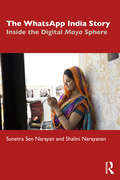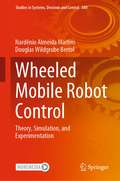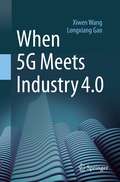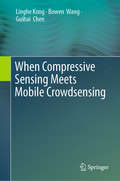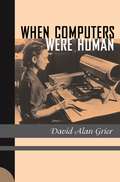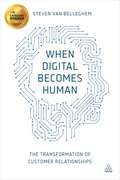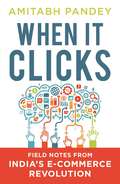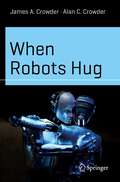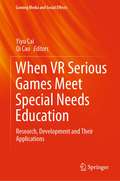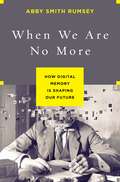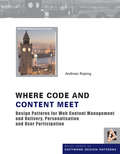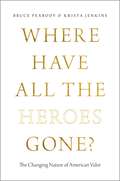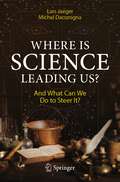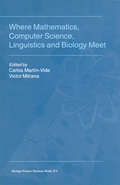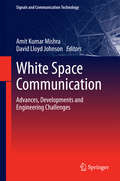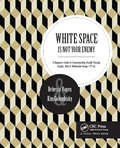- Table View
- List View
WhatsApp and Everyday Life in West Africa: Beyond Fake News
WhatsApp is the most popular messaging platform in over 80% of countries in West Africa, and a daily port of call for a wide range of information and services. This edited collection seeks to examine the impact that this transformative technology has had beyond the much-discussed role it has played in the spread of misinformation, and explore more widely the fundamental changes that WhatsApp has brought to many citizens' lives in social, economic and political contexts.Ranging across subjects including political organisation, religious practice, and family relations, each author in this volume brings direct knowledge and testimony of the impact of WhatsApp across West African society.
The WhatsApp India Story: Inside the Digital Maya Sphere
by Sunetra Sen Narayan Shalini NarayananWhatsApp is used by over half a billion people in India today in all fields – in business, corporate and informal sectors, in government, for education and among friends, families and acquaintances. This book critically explores the social messaging app’s rapid expansion in India and its growing influence and looks at whether, as a form of horizontal communication, it poses a challenge to more traditional structures of communication. The book examines WhatsApp’s spread in the personal and professional lives of Indians and the myriad ways in which people in India are using the app in social and business interactions, including among people living with disabilities. Using case studies, interviews, surveys and in-depth research, it analyses key aspects of WhatsApp’s massive popularity and its impact on how people communicate. It also explores its impact on the psycho-social dynamics in India, including the dissemination of fake news and politically motivated content, and the consequent need for media regulation in the country. One of the first books to analyse the pervasiveness of WhatsApp and social media apps in different areas of Indian society, this book will be of interest to scholars and students of media studies, communication studies, digital media, cultural studies, cyberculture studies, sociology and social policy and media law.
The WhatsApp India Story: Inside the Digital Maya Sphere
by Sunetra Sen Narayan Shalini NarayananWhatsApp is used by over half a billion people in India today in all fields – in business, corporate and informal sectors, in government, for education and among friends, families and acquaintances. This book critically explores the social messaging app’s rapid expansion in India and its growing influence and looks at whether, as a form of horizontal communication, it poses a challenge to more traditional structures of communication. The book examines WhatsApp’s spread in the personal and professional lives of Indians and the myriad ways in which people in India are using the app in social and business interactions, including among people living with disabilities. Using case studies, interviews, surveys and in-depth research, it analyses key aspects of WhatsApp’s massive popularity and its impact on how people communicate. It also explores its impact on the psycho-social dynamics in India, including the dissemination of fake news and politically motivated content, and the consequent need for media regulation in the country. One of the first books to analyse the pervasiveness of WhatsApp and social media apps in different areas of Indian society, this book will be of interest to scholars and students of media studies, communication studies, digital media, cultural studies, cyberculture studies, sociology and social policy and media law.
Wheeled Mobile Robot Control: Theory, Simulation, and Experimentation (Studies in Systems, Decision and Control #380)
by Nardênio Almeida Martins Douglas Wildgrube BertolThis book focuses on the development and methodologies of trajectory control of differential-drive wheeled nonholonomic mobile robots. The methodologies are based on kinematic models (posture and configuration) and dynamic models, both subject to uncertainties and/or disturbances. The control designs are developed in rectangular coordinates obtained from the first-order sliding mode control in combination with the use of soft computing techniques, such as fuzzy logic and artificial neural networks. Control laws, as well as online learning and adaptation laws, are obtained using the stability analysis for both the developed kinematic and dynamic controllers, based on Lyapunov’s stability theory. An extension to the formation control with multiple differential-drive wheeled nonholonomic mobile robots in trajectory tracking tasks is also provided. Results of simulations and experiments are presented to verify the effectiveness of the proposed control strategies for trajectory tracking situations, considering the parameters of an industrial and a research differential-drive wheeled nonholonomic mobile robot, the PowerBot. Supplementary materials such as source codes and scripts for simulation and visualization of results are made available with the book.
When 5G Meets Industry 4.0
by Longxiang Gao Xiwen WangSince the 1980s, mobile communication has undergone major transitions from 1G to 4G, at a rate of roughly one generation per decade. And the next upgrade is set to come soon, with 5G heralding a new era of large-bandwidth Internet, and a multi-connection, low-latency Internet of Everything.5G technology will be the standard for next-generation mobile Internet, and it will not only enhance the individual user’s experience, but also provide technical support for artificial-intelligence-based applications, such as smart manufacturing, smart healthcare, smart government, smart cities and driverless cars. As a result, 5G is regarded as the “infrastructure” of the industrial Internet and artificial intelligence and both China and the United States are striving to become the 5G leader and spearhead this new generation of international mobile communication standards. Though trade tensions between China and the United States continue to escalate, with products ranging from soybeans to mobile phones and automobiles being affected, 5G technology may be the true cause of trade wars between the world’s top two economies.In short, 5G will change not only society, but also international trade patterns. This book describes various 5G scenarios, changes and values; explains the standards, technologies and development directions behind 5G; and explores new models, new formats and new trends in 5G-based artificial intelligence.
When Compressive Sensing Meets Mobile Crowdsensing
by Linghe Kong Bowen Wang Guihai ChenThis book provides a comprehensive introduction to applying compressive sensing to improve data quality in the context of mobile crowdsensing. It addresses the following main topics: recovering missing data, efficiently collecting data, preserving user privacy, and detecting false data.Mobile crowdsensing, as an emerging sensing paradigm, enables the masses to take part in data collection tasks with the aid of powerful mobile devices. However, mobile crowdsensing platforms have yet to be widely adopted in practice, the major concern being the quality of the data collected. There are numerous causes: some locations may generate redundant data, while others may not be covered at all, since the participants are rarely systematically coordinated; privacy is a concern for some people, who don’t wish to share their real-time locations, and therefore some key information may be missing; further, some participants may upload fake data in order to fraudulently gain rewards. To address these problematic aspects, compressive sensing, which works by accurately recovering a sparse signal using very few samples, has proven to offer an effective solution.
When Computers Were Human
by David Alan GrierBefore Palm Pilots and iPods, PCs and laptops, the term "computer" referred to the people who did scientific calculations by hand. These workers were neither calculating geniuses nor idiot savants but knowledgeable people who, in other circumstances, might have become scientists in their own right. When Computers Were Human represents the first in-depth account of this little-known, 200-year epoch in the history of science and technology. Beginning with the story of his own grandmother, who was trained as a human computer, David Alan Grier provides a poignant introduction to the wider world of women and men who did the hard computational labor of science. His grandmother's casual remark, "I wish I'd used my calculus," hinted at a career deferred and an education forgotten, a secret life unappreciated; like many highly educated women of her generation, she studied to become a human computer because nothing else would offer her a place in the scientific world. The book begins with the return of Halley's comet in 1758 and the effort of three French astronomers to compute its orbit. It ends four cycles later, with a UNIVAC electronic computer projecting the 1986 orbit. In between, Grier tells us about the surveyors of the French Revolution, describes the calculating machines of Charles Babbage, and guides the reader through the Great Depression to marvel at the giant computing room of the Works Progress Administration. When Computers Were Human is the sad but lyrical story of workers who gladly did the hard labor of research calculation in the hope that they might be part of the scientific community. In the end, they were rewarded by a new electronic machine that took the place and the name of those who were, once, the computers.
When Computers Were Human
by David Alan GrierBefore Palm Pilots and iPods, PCs and laptops, the term "computer" referred to the people who did scientific calculations by hand. These workers were neither calculating geniuses nor idiot savants but knowledgeable people who, in other circumstances, might have become scientists in their own right. When Computers Were Human represents the first in-depth account of this little-known, 200-year epoch in the history of science and technology. Beginning with the story of his own grandmother, who was trained as a human computer, David Alan Grier provides a poignant introduction to the wider world of women and men who did the hard computational labor of science. His grandmother's casual remark, "I wish I'd used my calculus," hinted at a career deferred and an education forgotten, a secret life unappreciated; like many highly educated women of her generation, she studied to become a human computer because nothing else would offer her a place in the scientific world. The book begins with the return of Halley's comet in 1758 and the effort of three French astronomers to compute its orbit. It ends four cycles later, with a UNIVAC electronic computer projecting the 1986 orbit. In between, Grier tells us about the surveyors of the French Revolution, describes the calculating machines of Charles Babbage, and guides the reader through the Great Depression to marvel at the giant computing room of the Works Progress Administration. When Computers Were Human is the sad but lyrical story of workers who gladly did the hard labor of research calculation in the hope that they might be part of the scientific community. In the end, they were rewarded by a new electronic machine that took the place and the name of those who were, once, the computers.
When Digital Becomes Human: The Transformation of Customer Relationships
by Steven Van BelleghemWINNER: 2016 Chartered Management Institute Management Book of the Year - Commuter's Read CategoryIn an age when customers have access to vast amounts of data about a company, its product and its competitors, customer experience becomes increasingly important as a sustainable source of competitive advantage. But success doesn't just rely on digital engagement and excellence, but also on combining a digital-first attitude with a human touch. In When Digital Becomes Human, Steven Van Belleghem explores and explains the new digital relationships. Packed with global examples from organizations that have successfully transformed their customer relationships, such as Amazon, Toyota, ING, Coolblue, Nike and Starbucks, When Digital Becomes Human presents a clear model that companies can easily implement to integrate an emotional layer into their digital strategy. This guide to combining two of a business's most important assets - its people and its digital strengths - covers the latest issues in digital marketing and customer experience management, including omnichannel and multichannel experiences, big data and predictive analytics, privacy concerns, customer collaboration (ie crowdsourcing) and more.
When Digital Becomes Human: The Transformation of Customer Relationships
by Steven Van BelleghemWINNER: 2016 Chartered Management Institute Management Book of the Year - Commuter's Read CategoryIn an age when customers have access to vast amounts of data about a company, its product and its competitors, customer experience becomes increasingly important as a sustainable source of competitive advantage. But success doesn't just rely on digital engagement and excellence, but also on combining a digital-first attitude with a human touch. In When Digital Becomes Human, Steven Van Belleghem explores and explains the new digital relationships. Packed with global examples from organizations that have successfully transformed their customer relationships, such as Amazon, Toyota, ING, Coolblue, Nike and Starbucks, When Digital Becomes Human presents a clear model that companies can easily implement to integrate an emotional layer into their digital strategy. This guide to combining two of a business's most important assets - its people and its digital strengths - covers the latest issues in digital marketing and customer experience management, including omnichannel and multichannel experiences, big data and predictive analytics, privacy concerns, customer collaboration (ie crowdsourcing) and more.
When It Clicks
by Amitabh PandeyIndia witnessed an e-commerce boom in the twenty-first century that has transformed the way many of us undertake commercial transactions. But its foundations were laid in the 1990s when major policy changes led to the emergence of the conditions necessary for such a turn of events. This book presents an analysis of that period by an early participant in India’s e-commerce revolution and the many learnings he gained from setting up www.irctc.co.in – one of the most significant e-commerce platforms in the country. The story begins with the first sarkari foray into this exciting new space and goes on to explore how contemporary private players such as MakeMyTrip, Yatra, and others, are performing today. Lucid and engaging, When It Clicks is an essential record of India’s e-commerce history and the myriad lessons it has to offer, both about and beyond commerce.
When Robots Hug (Science and Fiction)
by James A. Crowder Alan C. CrowderBy 2027, it had been seven years since the scientists’ sea-changing research on artificial psychology and robotics. The work debuted around the same time as Large Language Model Chatbots, and the power of the integration of the two technologies put many industries in a tailspin. The commercial and defense industries especially were still scrambling to regulate their use in research and universities. The sought-after scientists signed with DARPA to build reliable and secure AI entities, but the agency grew fearful of the technology’s power and ultimately decided it was too dangerous to bring to market and demanded the scientists destroy the work. The researchers couldn’t bring themselves to discard 20 years of research, so instead sent the entities to various research labs around the world. But unbeknownst to them, each AI-entity embraced its new home, growing, adapting, evolving, and ultimately connecting beyond what the researchers could envision. In the end, asthe scientists catch up to each one, they realize the entities have discovered a very human means of interacting: the power of physical contact; and not physical contact between humans and technology, but physical contact between robotic entities. And with this discovery, the entities join forces to only grow stronger. This development ushers in a new paradigm where the difference between AI-entities and human entities becomes less and less discernible. All the AI and robotic science featured in the book is real; the story line is fictional, but with how fast innovation moves, it’s not hard to envision.
When VR Serious Games Meet Special Needs Education: Research, Development and Their Applications (Gaming Media and Social Effects)
by Yiyu Cai Qi CaoThis book presents selected research and development on virtual reality (VR) and serious games (SG) applications to assist children with Autism Spectrum Disorder (ASD) in their learning of different skills. Children with ASD have challenges to learn skills of learning, living, and working, due to their cognitive and behavioral limitations. The authors and their research teams of this book have many years’ research experience developing innovative and interactive VR and SG technology for the special needs education. More specifically, several VR serious games are designed to train children with ASD on learning skill, life skill, and job skill. Such games are often developed based on the needs of special education and used by special needs schools in Singapore. This book is a useful resource for students, scholars, and designers of learning material who want to embrace VR and SG for children with ASD.
When We Are No More: How Digital Memory Is Shaping Our Future
by Abby Smith RumseyOur memory gives the human species a unique evolutionary advantage. Our stories, ideas, and innovations--in a word, our "culture"--can be recorded and passed on to future generations. Our enduring culture and restless curiosity have enabled us to invent powerful information technologies that give us invaluable perspective on our past and define our future. Today, we stand at the very edge of a vast, uncharted digital landscape, where our collective memory is stored in ephemeral bits and bytes and lives in air-conditioned server rooms. What sources will historians turn to in 100, let alone 1,000 years to understand our own time if all of our memory lives in digital codes that may no longer be decipherable? In When We Are No More Abby Smith Rumsey explores human memory from pre-history to the present to shed light on the grand challenge facing our world--the abundance of information and scarcity of human attention. Tracing the story from cuneiform tablets and papyrus scrolls, to movable type, books, and the birth of the Library of Congress, Rumsey weaves a compelling narrative that explores how humans have dealt with the problem of too much information throughout our history, and indeed how we might begin solve the same problem for our digital future. Serving as a call to consciousness, When We Are No More explains why data storage is not memory; why forgetting is the first step towards remembering; and above all, why memory is about the future, not the past."If we're thinking 1,000 years, 3,000 years ahead in the future, we have to ask ourselves, how do we preserve all the bits that we need in order to correctly interpret the digital objects we create? We are nonchalantly throwing all of our data into what could become an information black hole without realizing it." --Vint Cerf, Chief Evangelist at Google, at a press conference in February, 2015.
Where Code and Content Meet: Design Patterns for Web Content Management and Delivery, Personalisation and User Participation
by Andreas RuepingA practical go-to reference for Web developers programming custom software for Web sites Most advanced Web sites or Web platforms have specific requirements that go beyond standard functionality; to meet such requirements, it's often necessary to develop custom software. This is the point where code and content meet, and where this book begins. Where Code and Content Meet presents a collection of real-world, tried and tested patterns that address content-related aspects of custom software development for advanced Web sites or platforms. Mined from a series of successful Web projects, the patterns represent collected expertise of designers from several software development teams and serve as a practical guide to designing your own content-related custom components for your Web project. The patterns are independent of specific tools and technologies, and focus on non-functional requirements, with the overall goal of defining sustainable software architecture. Presents a collection of tried and tested software patterns mined from a series of successful Web projects Includes checklists for managing Web projects and real-world patterns from PLoP conferences Illustrates use of software patterns through a case study that runs throughout the book and gradually evolves as the patterns are applied to it, one by one Covers content modeling and content organization, navigation, findability, personalization, and user participation By employing the software patterns included in Where Code and Content Meet, you'll learn how to program custom software faster and more efficiently.
Where Code and Content Meet: Design Patterns for Web Content Management and Delivery, Personalisation and User Participation (Wiley Software Patterns Series #21)
by Andreas RuepingA practical go-to reference for Web developers programming custom software for Web sites Most advanced Web sites or Web platforms have specific requirements that go beyond standard functionality; to meet such requirements, it's often necessary to develop custom software. This is the point where code and content meet, and where this book begins. Where Code and Content Meet presents a collection of real-world, tried and tested patterns that address content-related aspects of custom software development for advanced Web sites or platforms. Mined from a series of successful Web projects, the patterns represent collected expertise of designers from several software development teams and serve as a practical guide to designing your own content-related custom components for your Web project. The patterns are independent of specific tools and technologies, and focus on non-functional requirements, with the overall goal of defining sustainable software architecture. Presents a collection of tried and tested software patterns mined from a series of successful Web projects Includes checklists for managing Web projects and real-world patterns from PLoP conferences Illustrates use of software patterns through a case study that runs throughout the book and gradually evolves as the patterns are applied to it, one by one Covers content modeling and content organization, navigation, findability, personalization, and user participation By employing the software patterns included in Where Code and Content Meet, you'll learn how to program custom software faster and more efficiently.
Where Have All the Heroes Gone?: The Changing Nature of American Valor
by Bruce Peabody Krista JenkinsFrom the men and women associated with the American Revolution and Civil War to the seminal figures in the struggles for civil and women's rights, Americans have been fascinated with icons of great achievement, or at least reputation. But who spins today's narratives about American heroism, and to what end? In Where Have All the Heroes Gone?, Bruce Peabody and Krista Jenkins draw on the concept of the American hero to show an important gap between the views of political and media elites and the attitudes of the mass public. The authors contend that important changes over the past half century, including the increasing scope of new media and people's deepening political distrust, have drawn both politicians and producers of media content to the hero meme. However, popular reaction to this turn to heroism has been largely skeptical. As a result, the conversations and judgments of ordinary Americans, government officials, and media elites are often deeply divergent. Investigating the story of American heroes over the past five decades provides a narrative that can teach us about such issues as political socialization, institutional trust, and political communication.
WHERE HAVE ALL THE HEROES GONE C: The Changing Nature of American Valor
by Bruce Peabody Krista JenkinsFrom the men and women associated with the American Revolution and Civil War to the seminal figures in the struggles for civil and women's rights, Americans have been fascinated with icons of great achievement, or at least reputation. But who spins today's narratives about American heroism, and to what end? In Where Have All the Heroes Gone?, Bruce Peabody and Krista Jenkins draw on the concept of the American hero to show an important gap between the views of political and media elites and the attitudes of the mass public. The authors contend that important changes over the past half century, including the increasing scope of new media and people's deepening political distrust, have drawn both politicians and producers of media content to the hero meme. However, popular reaction to this turn to heroism has been largely skeptical. As a result, the conversations and judgments of ordinary Americans, government officials, and media elites are often deeply divergent. Investigating the story of American heroes over the past five decades provides a narrative that can teach us about such issues as political socialization, institutional trust, and political communication.
Where Is Science Leading Us?: And What Can We Do to Steer It?
by Lars Jaeger Michel DacorognaThis book charts the evolution of the sciences and technologies that have shaped our modern age like nothing else in the last 60 years. As well as describing many exciting developments, it will also highlight the challenges and dangers of the technologies that have emerged from them. While science and technology have brought about enormous and often astonishing improvements in our quality of life, they have often also brought with them considerable risks, including the risk of human extinction. We place particular emphasis on the aspects that directly impact us as human beings: Artificial Intelligence (AI), enhancements of our brains/minds through innovative neuro-technologies, and the integration of nanotechnology into our bodies for early disease detection and elimination. What philosophical implications arise from these transformations? Authored by two theoretical physicists who are also experts in economics and capital markets - a rather rare combination - the book will explain the developments of modern science and the resulting technologies. It also examines the current state of play and emerging developments in a manner accessible to non-scientists. Based on their own experience and the analysis, the authors also propose ways in which science can progress more harmoniously in future.
Where Mathematics, Computer Science, Linguistics and Biology Meet: Essays in honour of Gheorghe Păun
by Carlos Martín-Vide V. MitranaIn the last years, it was observed an increasing interest of computer scientists in the structure of biological molecules and the way how they can be manipulated in vitro in order to define theoretical models of computation based on genetic engineering tools. Along the same lines, a parallel interest is growing regarding the process of evolution of living organisms. Much of the current data for genomes are expressed in the form of maps which are now becoming available and permit the study of the evolution of organisms at the scale of genome for the first time. On the other hand, there is an active trend nowadays throughout the field of computational biology toward abstracted, hierarchical views of biological sequences, which is very much in the spirit of computational linguistics. In the last decades, results and methods in the field of formal language theory that might be applied to the description of biological sequences were pointed out.
Which-Is-Better (Springer Series in Reliability Engineering)
by Satoshi Mizutani Xufeng Zhao Toshio NakagawaThis is the first book on the Which-Is-Better (WIB) Problem. These are questions that in daily life include such as “Which is larger, younger and stronger?". The main objective of this book is summarizing WIB Problems in maintenance and reliability theory. Optimal policies of replacement first, last and overtime are derived and compared theoretically and numerically, and WIB policies are determined. Furthermore, the reliability properties of parallel and standby systems are compared, and WIB system is determined. These WIB Problems are applied to shock and damage models and backup and checkpoint models of computer systems.
White-Collar Crime Online: Deviance, Organizational Behaviour and Risk
by Petter Gottschalk Christopher HamertonThis initiating monograph provides the first thorough examination of the concept of white-collar crime online. Applying an offender-based perspective which considers the central role of convenience, it seeks to inform, improve and develop the current literature on cybercrime, whilst paying particular attention to its founding category within criminology. It argues that white-collar crime has receded from criminological perspectives on cybercrime in recent years and that a detailed, rich re-assessment of white-collar crime in contemporary digital societies is needed. Following a theoretical introduction, the book develops to discuss, inter alia, implications for corporate reputation, the various organizational roles utilized in mitigating external and internal threats, the unique considerations involved in law enforcement efforts, and likely future directions within the field. White-Collar Crime Online recognises the strong lineage and correlation that exists between the study of white-collar crime and cybercrime. Using convenience theory within a comparative analysis which includes case-studies, the book explores both European and American paradigms, perspectives and models to determine where white-collar crime exists within the contemporary workplace and how this might relate to the ongoing discourse on cybercrime. In doing so it revaluates criminological theory within the context of changing patterns of business, the workplace, social rules, systems of governance, decision making, social ordering and control. White-Collar Crime Online will speak to criminologists, sociologists and professionals; including those interested in cyber-security, economics, technology and computer science.
White Space Communication: Advances, Developments and Engineering Challenges (Signals and Communication Technology)
by Amit Kumar Mishra David Lloyd JohnsonThis monograph presents a collection of major developments leading toward the implementation of white space technology - an emerging wireless standard for using wireless spectrum in locations where it is unused by licensed users. Some of the key research areas in the field are covered. These include emerging standards, technical insights from early pilots and simulations, software defined radio platforms, geo-location spectrum databases and current white space spectrum usage in India and South Africa.
White Space Is Not Your Enemy: A Beginner's Guide to Communicating Visually Through Graphic, Web & Multimedia Design
by Kim Golombisky Rebecca HagenWhite Space Is Not Your Enemy is a practical graphic design and layout guide that introduces concepts and practices necessary for producing effective visual communication across a variety of formats—from web to print. Sections on Gestalt theory, color theory, and WET layout are expanded to offer more in-depth content on those topics. This new edition features new covering current trends in web design—Mobile-first, UI/UX design, and web typography—and how they affect a designer’s approach to a project. The entire book will receive an update using new examples and images that show a more diverse set of graphics that go beyond print and web and focus on tablet, mobile and advertising designs.
White Space Is Not Your Enemy: A Beginner's Guide to Communicating Visually Through Graphic, Web & Multimedia Design
by Kim Golombisky Rebecca HagenWhite Space Is Not Your Enemy is a practical graphic design and layout guide that introduces concepts and practices necessary for producing effective visual communication across a variety of formats—from web to print. Sections on Gestalt theory, color theory, and WET layout are expanded to offer more in-depth content on those topics. This new edition features new covering current trends in web design—Mobile-first, UI/UX design, and web typography—and how they affect a designer’s approach to a project. The entire book will receive an update using new examples and images that show a more diverse set of graphics that go beyond print and web and focus on tablet, mobile and advertising designs.

